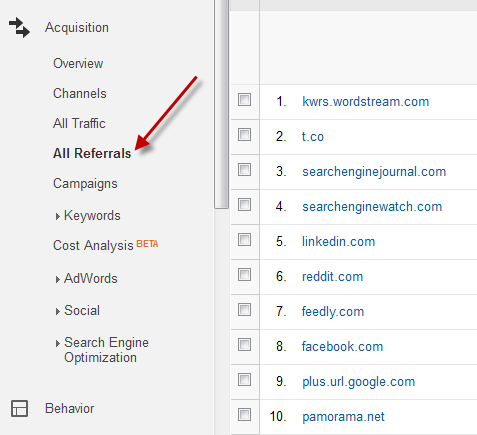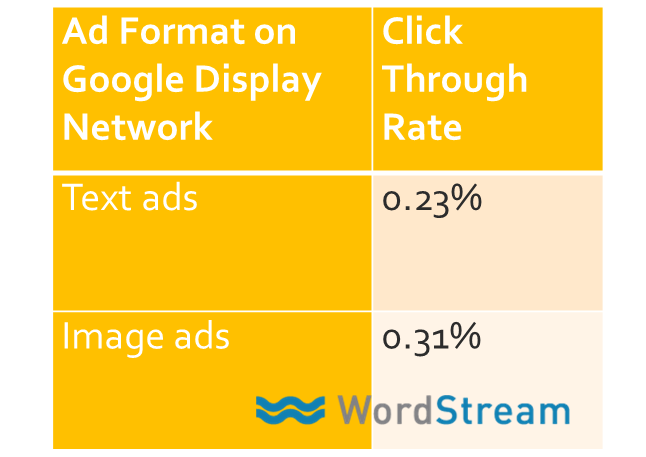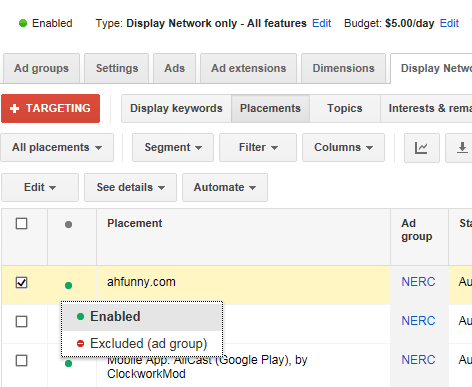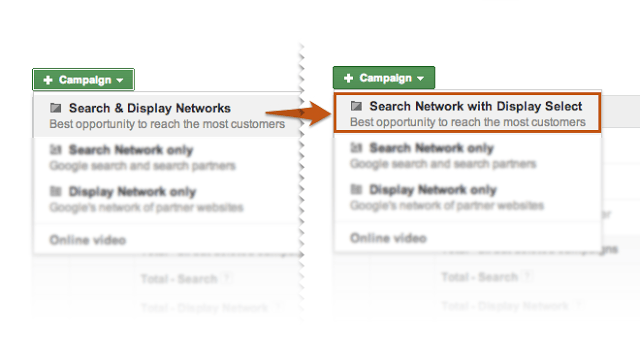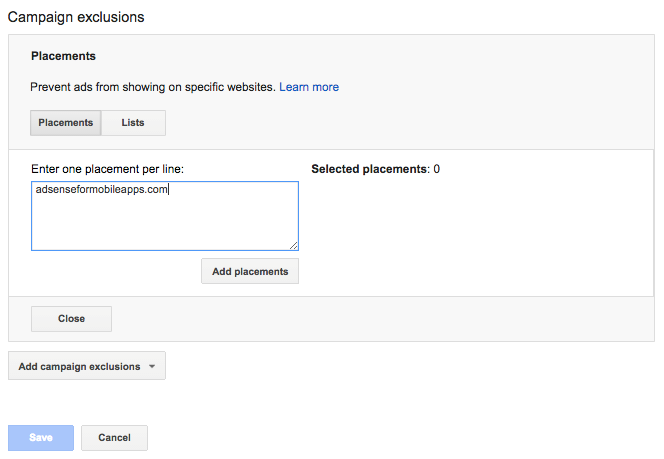
Want to master the Google Display Network? Follow these 7 tips and you’ll be well on your way.
What Is the Google Display Network?
Google AdWords is split into two networks, the Search Network and the Display Network. When advertising on the Search Network, businesses place text ads in the search engine results. On the Display Network, businesses instead place display ads on a huge network of sites across the internet.
What is a display ad?
An example of display advertising.
So how does the Google Display Network work? Display ads are the visual banner ads you see on advertising-supported sites everywhere, like the highlighted ads above or the examples in this post, or this other display ad examples post.
According to Google, the Display Network reaches over 90% of global internet users expanding across 2 million sites!
For those of you unfamiliar with the difference between display and search, let me give you a quick recap. Google’s Search Network targets users typing directly into Google’s search engine or Google partner search sites, if you opt to expand to Google Search Partners (like AOL). In contrast, think of the display network as a more passive form of advertising. You’ve likely already seen many display ads today, for example while perusing the Huffington Post or skimming your favorite blogs. You may or may not have noticed GDN banners or small boxes promoting a product or service, above and to the side of the articles you were reading – those are display ads.
Want a quick audit of your PPC campaigns? Get a free performance report in one minute or less!
WordStream’s Erin Sagin states, “When users are on the GDN, they may not necessarily be in ‘shopping mode.’ Instead, they are going about their daily internet activities—catching up on news, reading blog posts, watching video clips, etc.” You may be thinking, if they’re not in shopping mode, then what’s the point?
Hesitation to jump on the display network bandwagon is not uncommon, but as Paid Search Strategist Sergey Rusak explains, “Look at how much you spent in one month and how many impressions you received. You might be able to get the same amount of impressions in a local newspaper or a billboard on a highway, but you’ll end up spending hundreds upon thousands of dollars. With Display, you promote your brand and don’t even pay for these impressions.”
To get a clear picture of what works and what doesn’t work on the Google Display Network, I spoke with a few of WordStream’s top-notch PPC experts. What are they seeing when they’re running Google Ads account audits, or when they’re just making account optimizations on a daily basis?
All four of the people I interviewed work on our marketing services team, where they are fully emerged in Google AdWords accounts every day. Our team operates similar to an agency, managing AdWords accounts for clients and helping them achieve their business goals. Essentially, the experts on the team spend 40+ hours a week working directly in Google AdWords across the search and display networks, helping clients from a variety of industries. So yeah, they know a lot!
Here are seven bits of display network wisdom I learned from these experts, plus three display network mistakes to avoid.
Display Network Tip #1: Start with Remarketing
All experts unanimously agreed that remarketing is the place to start when it comes to the display network. Paid Search Strategist Mark Irvine says, “If you’re ever going to see any kind of return on the display network you’re going to see it from remarketing first.”
For those of you unfamiliar with remarketing, it is essentially when you cookie your past site visitors to follow them around with ads on various sites they browse. It might sound a bit creepy, but it works – because the people you’re remarketing to have already expressed a genuine interest in your business (because they visited your site, duh).
Remarketing is used to keep your past visitors engaged, “completing the whole circle of engagement,” says Paid Search Strategist Caleb Hutchings. The majority of those reading this post have likely been successfully remarketed to. Just the other day I was shopping for a pair of fall boots when a few days later that stylish high-kneed suede pair of black boots would not leave me alone. They kept appearing on multiple sites that I was on at various points during the week, until I finally gave in and took the plunge. If I wasn’t remarketed to, would I still have bought the boots? Probably, because I actually needed fall boots, BUT the chances of me getting that pair from that domain would have dropped significantly if remarketing was not in place. This is just one example of the power of remarketing, which has been seen to work across a variety of industries.
“Remarketing is always a good idea. Your CPA’s are generally much lower, you’re keeping people engaged. It’s essentially free advertising,” Caleb states. Remarketing is the best way to optimize your Google display ads.
Note: As of June 2020, Google Ads has extended Customer Match to the Display Network! This allows advertisers to create remarketing lists based on email addresses.
Display Network Tip #2: Utilize Managed Placements
Managed placements is the only targeting method that gives the advertiser granular control over where their ads are being placed. If you use methods like interests or topic targeting, Google is basically doing the decision-making for you and guessing which sites are relevant. Managed placements allows you to pick and choose exactly the sites that you want your ads to be displayed on, which is why it’s a safe bet when branching out into display. According to Caleb, “It’s the best way to have control because the people you’re targeting and conversions are consistent, so it tends to cost less.”
WordStream Paid Search Strategist Mike Griffith explains the process he uses with clients new to the Display Network: “We start as granular as possible, identifying 5-10 domains that are very applicable to the product or service and start serving up ads on those specific placements first. If the volume is limited, then we expand to other related sites.” But how do you know which sites are relevant? If you’re struggling to make that decision, Griffith advises digging into your top referral sites in Google Analytics.
Display Network Tip #3: Let Your Budget Guide You
“Since display is such a large space (reaching over 90% of the U.S. daily!) you need to be extremely careful when it comes to setting your budget,” Mark Irvine explains. He recommends starting out small with an amount that you are comfortable testing with.
Caleb explains how setting up a new display campaign is all about budgets. For example if you have a great list of managed placements, allocate more of your budget towards that campaign, and separate the different placements into their own ad groups so you can feed more money into the ad groups that contain the placement providing the best return.
Once you get a campaign or ad group running successfully and providing remarkable returns, the next step is to feed more money into it. Mark told me about one client who took their remarketing campaign from $1,000/month to $50,000/month and still saw great ROI! Another client in the travel industry was seeing such great return that they stopped running their search campaigns and reallocated that money to further grow their reach on display. “Remarketing and display are wonderful because once you hit it right you can just give it more money and get even more return. Your reach is pretty much unlimited,” Mark says.
Display Network Tip #4: Create Ads in Every Format Available
I know what you’re thinking … isn’t it a waste of time and resources to create an ad in EVERY format? Why should I create a text ad if image ads statistically outperform this format?
I understand these concerns, but the majority of WordStreamers agree: having an ad in every format is critical due to the fact that some websites will only support one format.
“Some people feel strongly that you shouldn’t include text ads. I’d say include them and make that decision later. Some placements are only going to support text ads and it could be a junk site or it could be Pandora, so just do it,” says Mark. “If you’re the only advertiser with a specific format, you’re going to get more exposure at a discount.”
Caleb recommends utilizing both image and text ads, but splitting them into different ad groups. “Text ads are displayed so often, but people prefer image ads because it resonates with them and tells more of a story.”
Display Network Tip #5: Create Ads That Are Simple and Visual
This tip seems obvious and yawn-worthy. That’s what I thought as well until I found out that 67.5% of ads on the display network are plain text ads! This is shocking, due to the fact that text ads have much lower click-through rates than image ads. Just check out this table from WordStream founder Larry Kim’s recent study.
This brings me to my next point: as important as it to include text ads in your display campaigns, image ads are a necessity! Sergey says “Ads need to be simple, visual, and easy to read.” Sergey goes on to explain how image ads perform best for visual industries that are naturally appealing, such as travel, where the destination can essentially sell itself. But even B2B companies see success with image ads. For one of Sergey’s clients, he tested out a banner ad with a “Download Now” image that linked right to a product page. This visual format far outperformed the text ads running and helped the company generate more leads.
Display Network Tip #6: Give Your Display Campaigns the Same Love You Give Search
For those of your running successful search campaigns, you have likely learned that continuously monitoring and adjusting your account is critical to continue knocking it out of the park. You can’t just rest on your laurels. You likely spend time each week evaluating your account, scraping through search query data, adjusting keyword bids, setting new negatives, restructuring campaigns, tweaking under-performing ads, and the list goes on. This should be no different with display!
“Look at last week and ask, how did it perform? Similar to how you want to add negative keywords with search, you might want to exclude placements with Display,” says Mark. “Display is a slightly different animal, but needs the same love.”
To see where your display ads are being placed, navigate to the “Display Network” tab in AdWords, making sure your Display campaign is selected on the campaign tree, and then select “Placements.” If you want to exclude a certain site, select the site and use the dropdown to change it to “Excluded” (see image below).
Sergey explains why monitoring this report and making sure your settings are correct is critical: “The majority of your impressions could come from weather.com, where people go for 3 seconds before work – they don’t have time to check out your product. Make sure you’re getting the right placements. You don’t want to be selling life insurance to 18 year olds or serving banners for college to people who are 60+.”
In addition to investigating these placements, monitoring and tracking your campaign to the best of your ability is essential to making changes and improving your return. “Tracking needs to be consistent. Google isn’t consistent with their algorithm so you could be showing on one site for a long period of time and then suddenly lose that placement due to an algorithm update,” says Sergey. “The metrics to focus on depends on your goals. For branding purposes, focus on impressions and clicks, and for sales-oriented goals focus on view-through conversions.”
Caleb recommends looking for conversions, but also looping in analytics to see metrics like time-on-site. Take a look at the top conversion paths to see how these different channels impact your overall conversions. “If you see display is helping organic or even paid search, it’s making an impact by introducing your brand,” he states. “This starts painting the picture of how display is working.” He goes on to explain that tracking is so critical because with Display, “you’re trusting Google to define your audience, but they’re not telling you how they define that, which can be tricky.”
Display Network Tip #7: Set Aside Some Budget for Testing
Another thing that stands out during PPC audits: lack of testing! As I’ve started time and time again, the Display Network is HUGE, which means your reach is pretty much endless. Google also continues to release new features and targeting methods to reach people, so if you’re not testing some of these options, you could be missing out on a plethora of potential customers.
“Once you’ve hit your main goal, use the leftover budget for testing,” Mike Griffith says. He explains that if your Display campaigns are performing well, then YouTube will probably work as well. Mike recommending setting 10-20% of your budget aside for testing.
Sergey likes to start testing right off the bat by creating separate ad groups for contextual targeting, topics, interests, and managed placements. Why? Interests could work great and topical targeting could be a budget-eater with no return. “Normally we don’t know what’s going to work and what’s not, so we need to figure this out,” Sergey says.
Mark makes a valid point as well: “Google Display is SO big and no advertiser can completely own it all. It’s all about finding your niche and using existing data from smaller campaigns to build your next larger campaign.” In order to do so you need to experiment!
3 Google Display Network Mistakes to Avoid
Now that we’ve gone over the best strategies to get the most out of your Google Display campaigns, let’s review what not to do. The experts here at WordStream have hit many bumps in the road while setting up and managing display network campaigns. So avoid these three display faux-pas and DON’T do the following:
1. DON’T Utilize Display Select
If you’ve been doing paid search you likely (or hopefully) know that combining search and display campaigns is a big no-no. I’ve caught clients who are confused as to why their click-through rates are so low and their budgets are being eaten up, but they’re not getting any conversions, and typically this is due to the mistake of advertising on both networks simultaneously.
In November of 2013, Google released a solution to combat these issues called Search Network with Display Select. Display Select essentially tells Google to use the majority of your budget on search and then the leftover advertising on display. They may have marketed it as a great solution, but it turns out Display Select isn’t all it turns out to be.
According to Mark, “Display Select is essentially letting Google figure out ‘what is good for you,’ which is never a good idea.”
Mike agrees: “Display Select blends your search ads into the Display Network and since it’s blended, I almost never see good performance with these campaigns.”
Google even discourages it themselves: “If you currently run Search and Display campaigns separately, we recommend you keep them separate for greater bidding, budgeting, and targeting flexibility.”
Moral of the story? Always keep Search and Display campaigns separate!
2. DON’T Over-Layer
As we’ve discussed, there are many ways to home in on your target audience within the vast sea of display; due to the massive size and diverse audience of the network it is necessary and critical to target appropriately. With so many options to choose from, some advertisers decide to layer methods on top of each other – for example placements, keywords, topics, interests, etc. – believing this will reduce unqualified impressions and clicks.
In reality, over-layering can cause a lot of problems. Mark explains that this is one the biggest issues he finds in client accounts: “When someone creates a new campaign and they go after so many different types of targeting at once, layering upon layering, they typically do not understand how this targeting works when layers are added on top of each other. If you want to do all of these options, test them out in different campaigns.” Over-layering can significantly reduce reach, negatively impact results, and lead to trouble tracking which methods are working or not.
3. DON’T Let Mobile Games Eat Up Your Budget
Did you ever think that kids could be the reason you are wasting a huge chunk of change on AdWords? Well, they could be! Toddlers are stealing their parents’ smartphones to play app games where unfortunately your ads are being displayed through the Display Network.
This is an issue that has appeared time and time again. The most common culprits are the Flashlight App, Flashcards for Babies, Photo Frame Editors, Doodling Apps, and Random Games. Sergey is all too familiar with this problem. “Within all those games the kids are moving their thumbs as fast as possible, clicking your ads by accident. This can cost you a lot! For example if you run a very expensive competitive banner (i.e. personal injury, rehab, law, etc.) each click can cost you a lot; a thousand impressions could transfer to around a thousand clicks on these apps.”
Check out Caleb’s recent blog post where he outlines how to exclude these mobile games so you’re not wasting your budget on toddlers. “A lot of people see they’re getting clicks and therefore don’t exclude these placements, not realizing these clicks are worthless. This in turn will botch all of the statistics you’re looking at it,” he says.
Now that you’ve heard from the experts, jump on the Display Network and start expanding your reach! Your audience is out there just waiting to be marketed to.
As Mark says, “Once you put your faith in it, Google Display is your ocean.”
Note: For display advertising tips during the pandemic, check out this post: 4 Tips for Better Display Advertising During COVID-19.


